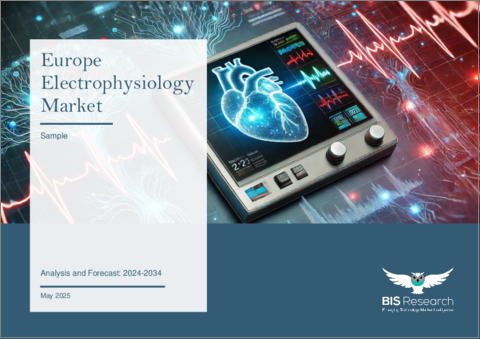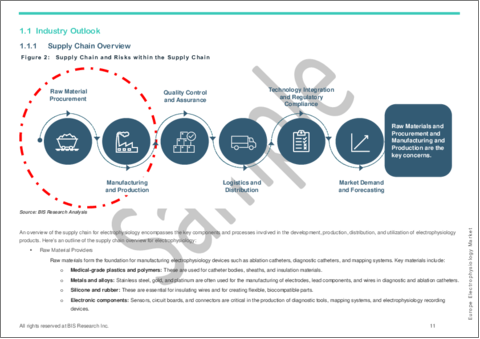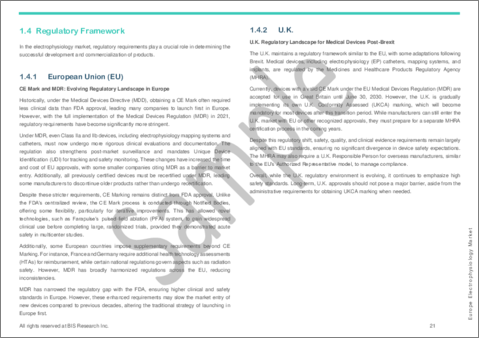|
|
市場調査レポート
商品コード
1732573
欧州の電気生理学市場:分析と予測(2024年~2034年)Europe Electrophysiology Market: Analysis and Forecast, 2024-2034 |
||||||
カスタマイズ可能
|
|||||||
| 欧州の電気生理学市場:分析と予測(2024年~2034年) |
|
出版日: 2025年05月23日
発行: BIS Research
ページ情報: 英文 65 Pages
納期: 1~5営業日
|
全表示
- 概要
- 図表
- 目次
欧州の電気生理学の市場規模は、2024年の24億9,000万米ドルから2034年には76億4,000万米ドルに達し、予測期間の2024年~2034年のCAGRは11.85%になると予測されています。
心血管系疾患、特に不整脈の有病率の上昇と、3D心臓マッピング、カテーテルアブレーションプラットフォーム、高度診断システムなどの新技術の迅速な開発が、欧州の電気生理機器市場を牽引しています。心臓疾患のリスクが高い高齢化により、低侵襲手技のニーズが高まっています。カテーテルを用いたアブレーションは、手技リスクが低く回復が早いため好まれています。心臓の健康に対する一般市民の意識の高まり、欧州のヘルスケアシステムの継続的な改善、公的機関や商業団体による重点的な投資などが、市場の急速な拡大に寄与しています。
市場イントロダクション
| 主要市場統計 | |
|---|---|
| 予測期間 | 2024年~2034年 |
| 2024年の評価 | 24億9,000万米ドル |
| 2034年の予測 | 76億4,000万米ドル |
| CAGR | 11.85% |
不整脈、特に心房細動の罹患率の増加と低侵襲心臓手術のニーズの高まりが、欧州の電気生理学(EP)産業を牽引しています。欧州の高齢化によって心臓のリズム異常の有病率が増加しているため、早期診断と効率的な治療が臨床的にも経済的にもますます重要になってきています。電気生理学者が心臓の異常な電気活動を特定し、位置を突き止め、治療する方法は、3D心臓マッピングシステム、高周波カテーテル、冷凍アブレーションカテーテル、AI対応ナビゲーションプラットフォームなどの先端技術によって革新されつつあります。
画像処理、マッピング、ロボットカテーテル制御を組み合わせたデジタル技術や、最新のEPラボ、ハイブリッド手術室は、欧州のヘルスケアシステム、特に欧米や北欧地域のヘルスケアシステムによって投資されています。有利な償還条件は、特に心房細動アブレーションにおいて、病院がインフラを改善し、サービス提供を増やすことを後押ししています。一方、ウェアラブルな心臓モニタリングや外来手術の要望により、患者のケアパラダイムは変化しつつあります。
しかし、まだ困難があります。それにもかかわらず、機器価格の高騰、有資格の電気生理学者の不足、EU諸国間の診療報酬の格差などが普及を妨げています。メーカーは、EU医療機器規制の下での規制遵守によってさらに複雑になっています。とはいえ、欧州のEP産業は、旺盛な臨床ニーズと技術革新のペースにより、持続的な成長が見込める位置にあります。
欧州電気生理学市場の動向・促進要因・課題
動向
- 高解像度3Dおよび超高密度心臓マッピングシステムの採用
- 自動不整脈基質同定のためのAIと機械学習の統合
- 遠隔およびロボットによるカテーテルナビゲーションプラットフォームの成長
- EP-イメージング複合施設の出現(MRI/CTとマッピングの重ね合わせ)
- 継続的なリズム監視のための装着型および埋め込み型モニタリング機器の拡大
促進要因
- 欧州の高齢化社会における心房細動およびその他の不整脈の有病率の上昇
- 低侵襲カテーテルアブレーション手技を支持する強力な臨床エビデンス
- 先進的EPインターベンションに対する西欧全域での償還支援
- 機器メーカー、病院、研究機関の連携別技術革新の促進
- より安全で効果的な不整脈治療に対する患者や医師の需要の高まり
課題
- 最先端のEPラボや機器のための高い資本コストとメンテナンスコスト
- EU加盟国間で細分化された償還の枠組みと変動する病院予算
- 専門的トレーニングの必要性と経験豊富な電気生理学者の不足
- 新規EP技術に対する規制の複雑さと承認までの道のりの長さ
- 従来の病院ITシステムと新しいEPプラットフォーム間のデータ統合と相互運用性のハードル
成長/マーケティング戦略:2022年1月から2024年12月までの欧州電気生理市場において、パートナーシップ、アライアンス、事業拡大が主要な発展の最大数を占めました。
競合戦略:欧州の電気生理学市場には、製品・サービスポートフォリオを持つ数多くの既存企業が存在します。本調査で分析・プロファイリングした欧州電気生理市場の主要企業には、電気生理製品・サービスを提供する既存企業が含まれます。
主要市場参入企業と競合情勢
プロファイリングされた企業は、主要専門家から収集したインプットと、企業カバレッジ、製品ポートフォリオ、市場浸透度の分析に基づいて選定されています。
当レポートでは、欧州の電気生理学市場について調査し、市場の概要とともに、国別の動向、および市場に参入する企業のプロファイルなどを提供しています。
目次
エグゼクティブサマリー
第1章 市場:業界展望
- 業界展望
- サプライチェーンの概要
- 償還シナリオ
- バリューチェーン分析
- 動向:現状と将来への影響評価
- 高度な3Dマッピングシステムとリアルタイムイメージングの導入増加
- 予測モデリングと個別化治療における人工知能の新たな活用
- 特許分析
- 特許出願動向(国別、年別)
- 規制の枠組み
- 欧州連合(EU)
- 英国
- フランス
- ドイツ
- イタリア
- スペイン
- 市場力学の概要
- 市場促進要因
- 市場抑制要因
- 市場機会
第2章 電気生理学市場(地域別)、100万米ドル、2022年~2034年
- 地域サマリー
- 欧州
- 地域概要
- 市場成長促進要因
- 市場成長抑制要因
- フランス
- イタリア
- ドイツ
- 英国
- スペイン
- その他
第3章 市場-競合ベンチマーキングと企業プロファイル
- 電気生理学市場:競合情勢
- 企業戦略2019年1月~2024年12月
- 戦略的取り組み(年度別)、2019年1月~2024年12月
- パートナーシップ、アライアンス、事業拡大
- 新しいサービス
- 規制当局の承認
- 資金調達活動
- 合併と買収
- 2015年から2023年までの主な発展とマイルストーン
- 企業プロファイル
- Koninklijke Philips N.V.
- Siemens Healthineers AG
- Volta Medical
- CathVision ApS
- Biotronik
第4章 調査手法
List of Figures
- Figure 1: Key Events to Keep Track of within the Electrophysiology Market
- Figure 2: Supply Chain and Risks within the Supply Chain
- Figure 3: Electrophysiology Market, Patent Analysis (by Country), January 2021-December 2024
- Figure 4: Electrophysiology Market, Patent Analysis (by Year), January 2021-December 2024
- Figure 5: Europe Electrophysiology Market, $Billion, 2022-2034
- Figure 6: France Electrophysiology Market, $Billion, 2022-2034
- Figure 7: Italy Electrophysiology Market, $Billion, 2022-2034
- Figure 8: Germany Electrophysiology Market, $Billion, 2022-2034
- Figure 9: U.K. Electrophysiology Market, $Billion, 2022-2034
- Figure 10: Spain Electrophysiology Market, $Billion, 2022-2034
- Figure 11: Rest-of-Europe Electrophysiology Market, $Billion, 2022-2034
- Figure 12: Corporate Strategies, January 2019-December 2024
- Figure 13: Share of Strategic Initiatives, January 2019-December 2024
- Figure 14: Strategic Initiatives (by Year), January 2019-December 2024
- Figure 15: Partnerships, Alliances, and Business Expansions, January 2019-December 2024
- Figure 16: New Offerings, January 2019-December 2024
- Figure 17: Regulatory Approval, January 2019-December 2024
- Figure 18: Funding Activities, January 2019-December 2024
- Figure 19: Merger And Acquisition, January 2019-December 2024
- Figure 20: Data Triangulation
- Figure 21: Top-Down and Bottom-Up Approach
- Figure 22: Assumptions and Limitations
List of Tables
- Table 1: Market Snapshot
- Table 2: Electrophysiology Market Trend Analysis
- Table 3: Impact Analysis of Market Navigating Factors, 2024-2034
- Table 4: Electrophysiology Market (by Region), $Billion, 2022-2034
Introduction to Europe Electrophysiology Market
The Europe electrophysiology market is projected to reach $7.64 billion by 2034 from $2.49 billion in 2024, growing at a CAGR of 11.85% during the forecast period 2024-2034. The rising prevalence of cardiovascular disorders, particularly arrhythmias, and the quick development of new technologies such as 3D cardiac mapping, catheter ablation platforms, and sophisticated diagnostic systems are driving the market for electrophysiology devices in Europe. The need for minimally invasive procedures is increasing due to an ageing population at higher risk of heart diseases; catheter-based ablations are preferred because of their lowered procedural risks and quicker recovery. Increased public awareness of heart health, ongoing improvements to the European healthcare system, and focused investments from public and commercial entities are all contributing to the market's rapid expansion.
Market Introduction
| KEY MARKET STATISTICS | |
|---|---|
| Forecast Period | 2024 - 2034 |
| 2024 Evaluation | $2.49 Billion |
| 2034 Forecast | $7.64 Billion |
| CAGR | 11.85% |
The growing incidence of arrhythmias, especially atrial fibrillation, and the growing need for minimally invasive cardiac procedures are driving the electrophysiology (EP) industry in Europe. Due to the increased prevalence of heart rhythm abnormalities brought on by Europe's ageing population, early diagnosis and efficient treatment are becoming more and more important from a clinical and financial standpoint. The way electrophysiologists identify, locate, and treat aberrant electrical activity in the heart is being revolutionised by advanced technology like 3D cardiac mapping systems, radiofrequency and cryoablation catheters, and AI-enabled navigation platforms.
Digital technologies that combine imaging, mapping, and robotic catheter control, as well as contemporary EP labs and hybrid operating suites, are being invested in by European healthcare systems, particularly those in the Western and Nordic areas. Favourable reimbursement conditions are pushing hospitals to improve infrastructure and increase service offerings, especially for atrial fibrillation ablation. In the meantime, patient care paradigms are changing due to the desire for wearable cardiac monitoring and outpatient operations.
But there are still difficulties. Adoption is nevertheless hampered by high equipment prices, a shortage of qualified electrophysiologists, and disparities in reimbursement between EU nations. Manufacturers are further complicated by regulatory compliance under the EU Medical Device Regulation. Nonetheless, Europe's EP industry is well-positioned for sustained growth due to robust clinical need and innovation pace.
Market Segmentation:
Segmentation 1: by Region
- Europe
- U.K.
- Germany
- France
- Italy
- Spain
- Rest-of-Europe
Europe Electrophysiology Market Trends, Drivers and Challenges
Trends
- Adoption of high-resolution 3D and ultra-high-density cardiac mapping systems
- Integration of AI and machine learning for automated arrhythmia substrate identification
- Growth of remote and robotic catheter navigation platforms
- Emergence of combined EP-imaging suites (MRI/CT overlay with mapping)
- Expansion of wearable and implantable monitoring devices for continuous rhythm surveillance
Drivers
- Increasing prevalence of atrial fibrillation and other arrhythmias in Europe's aging population
- Strong clinical evidence favoring minimally invasive catheter-ablation procedures
- Reimbursement support across Western Europe for advanced EP interventions
- Collaboration between device makers, hospitals and research institutes accelerating innovation
- Heightened patient and physician demand for safer, more effective heart-rhythm therapies
Challenges
- High capital and maintenance costs for state-of-the-art EP labs and equipment
- Fragmented reimbursement frameworks and variable hospital budgets across EU member states
- Need for specialized training and scarcity of experienced electrophysiologists
- Regulatory complexity and lengthy approval pathways for novel EP technologies
- Data-integration and interoperability hurdles between legacy hospital IT systems and new EP platforms
How can this report add value to an organization?
Growth/Marketing Strategy: The partnership, alliance, and business expansion accounted for the maximum number of key developments in the Europe electrophysiology market between January 2022 and December 2024.
Competitive Strategy: The Europe electrophysiology market has numerous established players with product and service portfolios. Key players in the Europe electrophysiology market analyzed and profiled in the study involve established players offering electrophysiology products and services.
Key Market Players and Competition Synopsis
The companies that are profiled have been selected based on inputs gathered from primary experts and analyzing company coverage, type portfolio, and market penetration.
Some prominent names in the Europe electrophysiology market include:
- Siemens Healthineers AG
- Biotronik
- Koninklijke Philips N.V.
Table of Contents
Executive Summary
Scope and Definition
1 Market: Industry Outlook
- 1.1 Industry Outlook
- 1.1.1 Supply Chain Overview
- 1.1.1.1 Risks within the Supply Chain
- 1.1.2 Reimbursement Scenario
- 1.1.2.1 Overview
- 1.1.2.2 Europe
- 1.1.3 Value Chain Analysis
- 1.1.3.1 Overview
- 1.1.3.2 Stakeholders at Each Stage of the Value Chain
- 1.1.3.3 Strategic Partnerships, Mergers, and Acquisitions in the Value Chain
- 1.1.1 Supply Chain Overview
- 1.2 Trends: Current and Future Impact Assessment
- 1.2.1 Increasing Adoption of Advanced 3D Mapping Systems and Real-Time Imaging
- 1.2.2 Emerging Use of Artificial Intelligence in Predictive Modelling and Personalized Treatment
- 1.3 Patent Analysis
- 1.3.1 Patent Filing Trend (by Country, Year)
- 1.4 Regulatory Framework
- 1.4.1 European Union (EU)
- 1.4.2 U.K.
- 1.4.3 France
- 1.4.4 Germany
- 1.4.5 Italy
- 1.4.6 Spain
- 1.5 Market Dynamics Overview
- 1.5.1 Market Drivers
- 1.5.1.1 Innovative Technological Developments
- 1.5.1.2 Proliferation of New Entrants and Its Market Implications
- 1.5.1.3 Expanding Investments, Funding, and Grant Support for Cardiac Surgery and Electrophysiology
- 1.5.1.4 Increasing Disease Incidence and Procedural Volume
- 1.5.2 Market Restraints
- 1.5.2.1 High Product Costs and Inadequate Reimbursement Policies
- 1.5.2.2 Increasing Device Reuse and Reprocessing Trends
- 1.5.3 Market Opportunities
- 1.5.3.1 Expansion of Emerging Markets
- 1.5.3.2 Next-Generation Ablation Technologies
- 1.5.1 Market Drivers
2 Electrophysiology Market (by Region), $Million, 2022-2034
- 2.1 Regional Summary
- 2.2 Europe
- 2.2.1 Regional Overview
- 2.2.2 Driving Factors for Market Growth
- 2.2.3 Factors Challenging the Market
- 2.2.4 France
- 2.2.5 Italy
- 2.2.6 Germany
- 2.2.7 U.K.
- 2.2.8 Spain
- 2.2.9 Rest-of-Europe
3 Markets - Competitive Benchmarking & Company Profiles
- 3.1 Electrophysiology Market: Competitive Landscape
- 3.1.1 Corporate Strategies, January 2019-December 2024
- 3.1.2 Strategic Initiatives (by Year), January 2019-December 2024
- 3.1.3 Partnerships, Alliances, and Business Expansions
- 3.1.4 New Offerings
- 3.1.5 Regulatory Approval
- 3.1.6 Funding Activities
- 3.1.7 Merger and Acquisition
- 3.1.8 Key Developments and Milestones, 2015-2023
- 3.2 Company Profiles
- 3.2.1 Koninklijke Philips N.V.
- 3.2.1.1 Overview
- 3.2.1.2 Top Products
- 3.2.1.3 Top Competitors
- 3.2.1.4 Target Customers
- 3.2.1.5 Analyst View
- 3.2.2 Siemens Healthineers AG
- 3.2.2.1 Overview
- 3.2.2.2 Top Products
- 3.2.2.3 Top Competitors
- 3.2.2.4 Target Customers
- 3.2.2.5 Analyst View
- 3.2.3 Volta Medical
- 3.2.3.1 Overview
- 3.2.3.2 Top Products
- 3.2.3.3 Top Competitors
- 3.2.3.4 Target Customers
- 3.2.3.5 Analyst View
- 3.2.4 CathVision ApS
- 3.2.4.1 Overview
- 3.2.4.2 Top Products
- 3.2.4.3 Top Competitors
- 3.2.4.4 Target Customers
- 3.2.4.5 Analyst View
- 3.2.5 Biotronik
- 3.2.5.1 Overview
- 3.2.5.2 Top Products
- 3.2.5.3 Top Competitors
- 3.2.5.4 Target Customers
- 3.2.5.5 Analyst View
- 3.2.1 Koninklijke Philips N.V.
4 Research Methodology
- 4.1 Data Sources
- 4.1.1 Primary Data Sources
- 4.1.2 Secondary Data Sources
- 4.1.3 Data Triangulation
- 4.2 Market Estimation and Forecast






